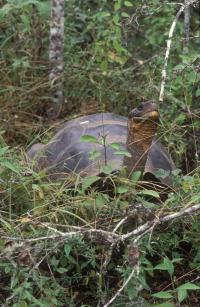
Hybrid tortoise on Volcano Wolf. Yale scientists report that genetic traces of extinct species of Galapagos tortoises exist in descendants now living in the wild, a finding that could spur breeding programs to restore the species, The report appears in Proceedings of the National Academy of Sciences.
When Darwin first visited the island of Floreana in 1835 and wrote about the giant tortoises, heavy human exploitation was already decimating the population. Within a few decades, 4 of the 15 known species had disappeared. On some islands, tortoises were sacrificed for oil that was used to light the streetlights of Quito, Equador. Others were taken as food or ballast for pirate and whaling ships.
Museum specimens and current molecular technology, coupled with 15 years of field work studying the tortoise population present now on the Galapagos archipelago by Gisella Caccone and Jeffrey Powell, faculty in the Department of Ecology & Evolutionary Biology, has painted a new picture of the origins and future of some of the tortoises. __IMAGE_2
"Connecting the past and present through genetic markers identified in the museum specimens — including the extinct species — has been key," said Caccone.
The database they established includes information from more than 2000 animals — so they know the genetic profile of each population. Their data show that all the known species and taxons of tortoises are genetically unique, which allows them to identify animals whose genetic information came from another species.
Matching museum specimens to current populations showed both distinct lineages and intermingled species. Of particular note, the team found tortoises on Volcano Wolf of the island Isabella — the furthest separated island of the archipelago — that had both the mitochondrial DNA and nuclear markers of the Floreana lineage.
"The population on Volcano Wolf is the most heterogeneous population we have seen," said Powell. He postulates that this island was the last stop for whaling and pirate ships heading out across the ocean to jettison their tortoise "ballast." Before they could retrieve the tortoises on a return trip, they the animals likely wandered and interbred.
Genes of the famous "Lonesome George" were also found in the Volcano Wolf population.
Hybrids of the extinct Floreana tortoise line theoretically now could be bred, the researchers say, and over a long span, revive this species. With this in mind, an expedition on Volcano Wolf is planned in December 2008 to look for tortoises bearing the Floreana lineage. Work is also under way to completely sequence the tortoise genome to gain a better understanding of these animals.
Source : Yale University
 Print Article
Print Article Mail to a Friend
Mail to a Friend
